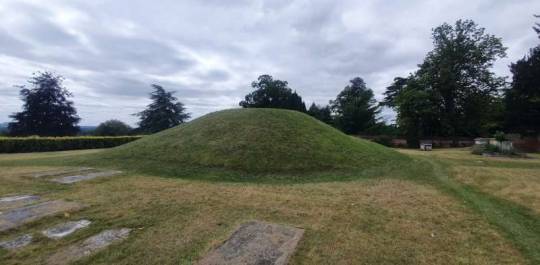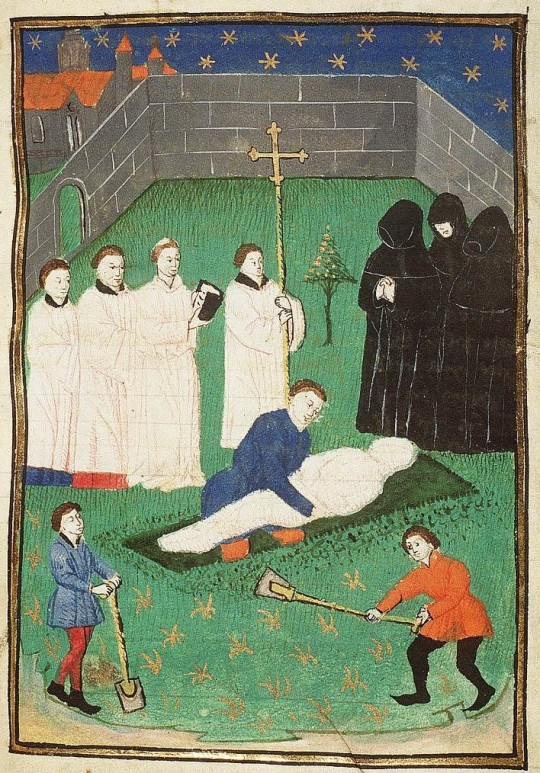#burials
Text
The burials that could challenge historians' ideas about Anglo-Saxon gender

There are a significant number of Anglo-Saxon burials where the estimated anatomical sex of the skeleton does not align with the gender implied by the items they were buried with. Some bodies identified as male have been buried with feminine clothing, and some bodies identified as female have been found in the sorts of "warrior graves" typically associated with men.
In the archaeology of early Anglo-Saxon England, weaponry, horse-riding equipment and tools are thought to signal masculinity, while jewelry, sewing equipment and beads signal femininity. And, for the most part, this pattern fits.
So far though, no convincing explanation has been put forward for the burials which appear to invert the pattern. My Ph.D. research asks whether looking at these atypically gendered burials through the lens of trans theory and the 21st-century language of "transness" has the potential to improve historians' understanding of early Anglo-Saxon gender. Read more.
1K notes
·
View notes
Text

a burial on a graveyard
miniature from a composite manuscript, central france, c. 1450-70
source: The Hague, KB, 73 J 55, fol. 94r
153 notes
·
View notes
Text
Deep Water Prompt #3222
We bury our dead with preserved foods. If they have unfinished business, they will wake in ten years, feast, and claw their way back to the surface as young men and women.
120 notes
·
View notes
Text
Review of The Horse, the Wheel, and Language: How Bronze-Age Riders from the Eurasian Steppes Shaped the Modern World by David W. Anthony

I will be upfront, it is a very technical book. If you are not well versed in the anthropological categorizing of cultures and time periods of the areas being discussed it can be very difficult to keep up with the more finite points the author is making. That being said, I had never heard of any of the specific cultures being discussed in the Danube Valley and was still able to enjoy this book and its well put together analysis of various aspects of language, culture, technological developments and shifts in behaviors and place.
If you are especially interested in any of the major themes this book discusses (which is in all honesty is an extensive list including but not limited to; the development of Indo-European language, the time periods and locations as well as likely motivation for domestication of various livestock types, the cultural effects of technological developments on the peoples of the Eurasian Steppes and their migration/trading patterns) I do highly recommend. It is heavy reading but extremely illuminating.
#The horse the wheel and language#David W Anthony#historical anthropology#anthropologist#anthropology#ancient languages#language#historical linguistics#linguistics#proto indo european#indo european#steppes#eurasian#eurasian steppe#horse#horses#husbandry#burials#Cattle#sheep#book review
158 notes
·
View notes
Text
The triumphant return of Ukraine's treasures ends a battle over ownership of priceless Scythian gold, but it is a bitter-sweet victory as the current war with Russia ‘destroys cultural heritage at a scale not seen since the Second World War’ claims report.
63 notes
·
View notes
Note
ThunderClan bury their dead, and RiverClan send them down the river, but what do the other Clans do with their dead? apologies if this is already in the lore posts and I missed it, I looked but couldn't find any info
Shoot, I knew there was a lore post I hadn't put up yet. It hasn't changed from the Redux, thankfully.
ShadowClan likes to take their dead to the Mother and bury them under the stones piled up on her back. It's believed that this is the easiest way for them to find StarClan, since their souls will leave their body at the holy site and directly under the stars.
WindClan, to everyone else's horror, prefers to take their bodies to a location outside of the territories and give them over to other predators to eat. This strengthens their bonds with their other animal friends and curries favor, as well as nicely handling the problem of bodies potentially piling up in their territory, where burying will only cause the collapse of their tunnel system.
25 notes
·
View notes
Text

Ancient Genomes Reveal the Presence of Down Syndrome in Past Societies
Burials show children with Down Syndrome and Edwards Syndrome were recognized members of their communities.
https://www.archaeologs.com/n/ancient-genomes-reveal-the-presence-of-down-syndrome-in-past-societies
//
Eski Genomlar Down Sendromunun Geçmiş Toplumlarda Varlığını Ortaya Koyuyor
Gömüler, Down Sendromlu ve Edwards Sendromlu çocukların toplumlarının birer üyesi olarak tanındıklarını gösteriyor.
https://www.archaeologs.com/n/eski-genomlar-down-sendromunun-gecmis-toplumlarda-varligini-ortaya-koyuyor
#archaeologs#archaeological#archaeology#history#dictionary#news#archaeological news#burials#ancient genomes#arkeoloji#haber#tarih
27 notes
·
View notes
Text
Stone Age Childhoods
Probably the most numerous social category in any Neanderthal group was children. Born stronger than us, intense activity further toughened their little bodies. Even before the age of 10, in Uzbekistan the Teshik-Tash child's legs must have walked huge amounts, while Le Moustier 1's teenage arms were almost as muscly as an adult's. Youngsters' teeth also show them practicing or joining in with adult tasks: at Sima de los Huesos, older children and teenagers had already begun to wear off their enamel. But even the littlest ones here and elsewhere have some distinctive clamping wear, suggesting that hide working was one thing they started to help with early on.
Overall, children's tooth micro-wear increases with age, but it's more complex than just greater amounts of mouth use. Micro-scratches in the young boy from El Sidrón were not only fewer but also diagonal, rather than vertical. This means he'd learned to eat like a grown-up using a lithic, but wasn't really doing a lot of other tasks with his mouth. There's a hint of the social settings where he and other children may have been learning and copying, since their overall tooth damage pattern on average resembles women's more than men's.
Neanderthal children certainly learned by doing, and from birth had front row seats for most of the tasks they needed to master as adults, whether slicing fat off muscle, eating around a hearth or walking the land. There was probably some teaching for particularly complicated things, but Western standards of appropriate child safety and supervision aren't shared by all societies. In many hunter-gatherer cultures youngsters will play with sharp tools, sometimes wielding them even before they can walk, and independently forage together. But busy childhoods brought with them a high cost, which some of the youngest paid.
[...]
Perhaps it's not surprising that some older Neanderthals weathered wretched health. But more unexpected are quite severe injuries in some juveniles. Le Moustier 1 is a case in point: he sustained a nasty broken jaw that healed badly, and probably caused asymmetric wear on his teeth from prolonged difficulty eating. As well as potentially affecting verbal communication, this tells us it happened sometime well before his death, [which happened] between 11 and 15 years old.
And even younger children were battered about. Less than a kilometre from Forbes' Quarry in Gibraltar is the Devil's Tower fissure site, explored in 1925 by a young Dorothy Garrod. What she found [...] was the remains of a child of no more than 5 years old with a broken jaw. Even more shocking, it had happened at least a couple years before, and he had also sustained later, potentially fatal skull fractures. Would such a young child have been involved in risky activities like hunting, or are we looking at accidents while unsupervised?
[...]
Youth for early H. sapiens people wasn't any less tough than for Neanderthals either. Another spectacular burial at Sunghir is of two children buried head-to-head. Both had more than one phase of tooth growth interruptions, and one's thigh bones were extremely short and bowed, probably from a genetic condition. The other's facial bones were also abnormal, and probably made eating difficult: they had no tooth wear, suggesting that special soft foods were provided. We can even find a match for the battered little Devil's Tower boy in the early H. sapiens skeleton of a 4- to 5-year old at Lagar Velho, Portugal. As a toddler he'd suffered a severe facial blow and healed a serious arm injury. Not long before death his teeth record several growth interruptions within a few months of each other, suggesting serious illness.
- Dr. Rebecca Wragg Sykes (Kindred: Neanderthal Life, Love, Death, and Art, pages 73-74, 79, 81-82)
8 notes
·
View notes
Text
May you feel this, while you sleep, push the poisonous thorns in you.
#afi#a fire inside#burials#the embrace#davey havok#hunter burgan#adam carson#jade puget#alternative#alternative rock#post punk#gothic#gothic rock#gothic punk#punk#punk rock
16 notes
·
View notes
Video
youtube
AFI - 17 Crimes

Angie/Maddie🦇❥✝︎🇺🇸
3 notes
·
View notes
Text

STONE'S COLD DISQUIET
A paper palace and an absent goddess and a darkened necropolis divided in three.
13/2 - 19/2
#dungeon23
Not a dungeon---but what is a dungeon, anyway? Here: have a tomb city, instead. People used to be buried here, as statues, in cold stone apartments. But then somebody woke them up.
Backstory I didn't have space to include (read: "forgot to include because I was too preoccupied fitting the text neatly into each day's box):
These statues are carved from stone into the likeness of the deceased, then daubed with their cremated ash, investing them with the spirits of the dead. After what happened here, Garika's temple now scatters ash into the sea.
Obvious rip-offs of Weeping Angels, these statues. But I thought that: "statues that are suddenly on the edge of your torch-light" was too appropriate an image to pass up ...
Also pleased with the image (sound?) of Green Maisara's earrings jingling in the dark.
This one connects to a whole lot of other stuff:
Thematically linked to the statues of the tomb of Queen Lessa;
Details the funerary rites of the non-Sea Peoples of the region;
References the God-In-Pieces, including his dong;
Garika's priestesshood has relocated across the bay;
Now the docks and shrines have been repurposed by the plantation detailed in January, serving the city described in December.
Trying to let the visuals carry more information. Ajun's face has so little detail compared to the other two, because Ajun used to be a bondsperson in life, and the poor are not afforded definition.
+
#dungeon23 thing I loved this week: Benj's Giant Tree Dungeon. Am loving the everyday details in the Temple.
28 notes
·
View notes
Text
Does anyone have or know where I can find copies of Elizabeth O’Brien's
2009. ‘Pagan or Christian? Burial in Ireland during the 5th to 8th centuries AD'
2003. 'Burial Practices in Ireland, First to Seventh centuries AD'
I've looke everywhere I can think of and can't find copies of them, not even for purchase. I found a few articles that outline chunks of the information but not the papers themselves
#Elizabeth O’Brien#irish#Ireland#archaeology#academic research#academic#burials#burial#burial practice#irish burial practice#pagan burials#early Christian burials#early Christian#Christian ireland#pagan ireland
25 notes
·
View notes
Photo

Tower Hamlets Cemetery Park, Tower Hamlets
I visited Tower Hamlets Cemetery Park with the aim to photograph gravestones in an urban environment. However I found the cemetery more historically fascinating than urban so I will post more photographs on Sometimes London. The first one is here. I have also posted one as my daily photograph on An Every Day Thing here
#London#tower hamlets#cemetery#graveyard#gravestones#graves#dead#death#urban#urban photography#documentary photography#history#historical#burials#England#UK
22 notes
·
View notes
Text
Archaeologists discovered an intact Etruscan tomb in the necropolis of Vulci, Italy. The double-chambered tomb is filled with exquisite artifacts offering insights into the affluent Etruscan culture and its international wine trade in the 7th-century BC.
#burials#tombs#Vulci#necropolis#Italy#amphorae#Etruscan#pottery#elite#chambers#ancient#history#ancient origins
54 notes
·
View notes